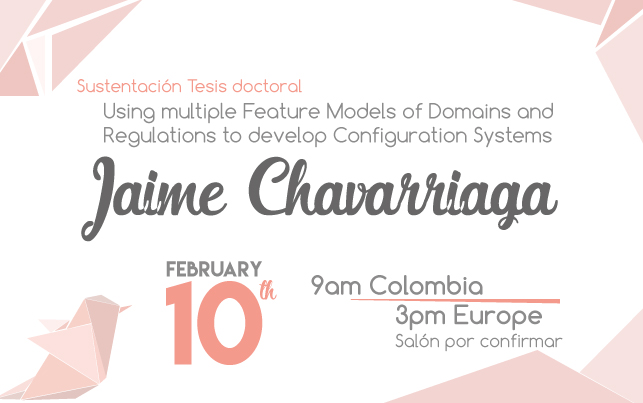
Título a obtener:
- Doctor of Philosophy in Engineering - Universidad de Los Andes
- Doctor of Philosophy in Sciences - Vrije Universiteit Brussel
Tesis: Using multiple Feature Models of Domains and Regulations to develop Configuration Systems
Advisors:
- Prof. Dr. Rubby Casallas
- Prof. Dr. Viviane Jonckers
Jury:
- Prof. Dr. Mathieu Acher - Universite of Rennes 1
- Prof. Dr. David Benavides - Universidad de Sevilla
- Prof. Dr. Philippe Cara - Vrije Universiteit Brussel
- Prof. Dr. Dario Correal - Universidad de Los Andes
- Prof. Dr. Wolfgang De Meuter - Vrije Universiteit Brussel
- Prof. Dr. Kelly Garces - Universidad de Los Andes
Viernes 10 de febrero del 2017 Salón por confirmar 9am Colombia / 3pm Europe Fecha:
Lugar:
Hora:
¡Los esperamos!
A Configuration System is a software tool that guides users to specify products by selecting options and preventing con icts among these choices. In Feature-based Configuration, these systems use Feature Models to represent the configuration options and constraints. Feature models have been found easy to understand by non-technical users and easy to analyze using automated tools and solvers.
Configuration Systems for complex products such as Cars or Electrical Transformers are usually hard to model and create. First, these products comprise multiple domains of the concern of different domain experts. Second, these domains very often have interactions among them; Third, there are standards and regulations that may vary from one country to the other determining which features in each domain must be present or not. And finally, these domains and standards are usually shared across multiple product families. Trying to use a single model that represents all the domains, standards and families results in a model with a large number of elements, and therefore, hard to create, process, and maintain.
This dissertation aims to overcome some limitations of the existing approaches for modeling and creating configuration systems in the presence of multiple domains and standards: First, we propose an approach where the diverse domains and standards are modeled using multiple artifacts: feature models for each domain, constraint sets representing the interactions among the domains, and feature models for the standards. Second, we propose a new set of automated operations for feature models such as the Conditional Intersection Merge and the Partial Conditional Intersection to combine feature models for domains and for standards. And third, we propose a strategy to derive automatically the corresponding Configuration Systems. In addition, we built a complete implementation of tools to support the process and have applied our approach in an industrial case study.



